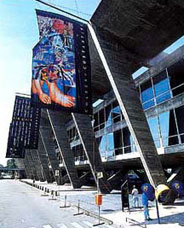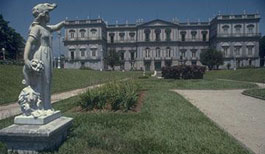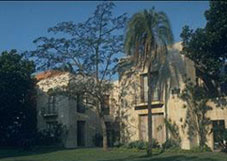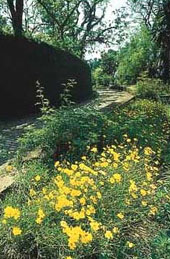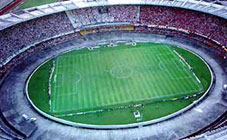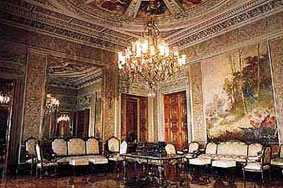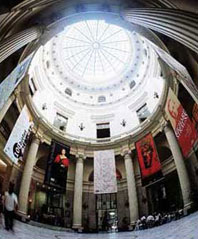Modern Art Museum
Inaugurated in 1958, the Modern Art Museum has a very unusual history. It has
a privileged location on Flamengo Park alongside Guanabara Bay, close to downtown.
After a disastrous fire in 1978, hundreds of people all over the world flocked
to rebuild this cultural treasure, helping repair the building (130 meters x
25 meters) and replace its collections. It currently houses some 1,700 works
including paintings, sculptures and engravings by Brazilian and foreign artists,
in addition to a specialized art library and a well-known cinemathèque that
is among the most popular in town.
National
History Museum
In an harmonious architectural complex this museum was established in 1922 during
the Epitácio Pessoa Government. Covering an area of 18.000m², the National History
Museum is housed in three separate buildings constructed at different times:
the Casa do Trem (1762); the Royal Arsenal (1822); and the Barracks Annex (1835).
Once set right on the
seafront,
it was originally planned as a strategic factor in the defense of the city.
Today it is home to a priceless cultural treasure trove.
International Primitive Art Museum
Rio is home to the world's largest and most complete collection of primitive
art. Just fifty meters from the mini-train station leading to Christ the Redeemer
in the Cosme Velho District, 8,000 works by painters from Brazil and 130 other
countries give testimony to this spontaneous and very unacademic type of artistic
expression, dating back to the XV Century. This museum also features the largest
canvas ever painted in this style, measuring 7 x 4 meters, which portrays
the City of Rio de Janeiro in a strikingly original way. It also offers a
dynamic cultural program that attracts a steady flow of interested visitors.
Chácara
do Céu Museum
Once the home of art collector and industrialist Raymundo Ottoni de Castro Maya,
the Chácara do Céu Museum in Santa Teresa links art, history and nature
in
flawless harmony. Home to a large collection of books, as well as paintings,
ceramics, furniture and objets d'art, outstanding items include works by artists
such as Picasso, Matisse, Dali, Miró, Marcoussis, Di Cavalcanti, and Portinari,
as well as a large collection of watercolors and drawings by Debret.
Rio
de Janeiro Municipal Theater
Located near the National Library, the National Fine Arts Museum and the Pedro
Ernesto Palace, the Municipal Theatre faces the spacious Cinelândia Square.
Its attractive architectural design catches the eye, with its imposing facade,
paralleled by the beauty of its interior decoration. Built of fine colored Carrara
marble, bronze and onyx, it is outfitted with mirrors and period furniture,
paintings and sculptures. Seating 2,200 people, this theater is a true temple
of culture that is just as popular with visitors as the performances staged
here.

Maracanã Soccer Stadium
Inaugurated in June 1950, the world's largest sports stadium still retains all
the glamour that makes it a landmark and an irresistible attraction for visitors
to Rio. The stage of memorable moments such as Pelé's 1,000th goal, Maracanã
also hosted mega-concerts by Frank Sinatra and Paul McCartney, drawing huge
audiences of over 180,000 which made the Guinness Book of Records. More recent
and no less important was the
Meeting
with Families during Pope John Paul II's last visit to Brazil. With this impressive
track-record, Maracanã leaves a lasting impression, thanks to its sheer size,
style and beauty. This monument to sport is open for visits almost every day
at various times.
Catete
Palace & Republic Museum
The seat of Brazil's Republican Government from 1897 through 1960, the neo classical
facade of the Catete Palace is faced with granite and pink marble, its gateways
framed in white marble. No less than eighteen presidents of Brazil have passed
through its doors, and some of the most important events in the nation's history
have taken place here, including decisions to fight in both World Wars and the
suicide of President Getúlio Vargas.
Transformed
into a museum after the Federal Capital moved to Brasilia, this palace today
features a busy cultural agenda, in addition to a bookstore, bar, restaurant
and souvenir boutique. Its attractive gardens offer moments of peace during
the day, and a venue for pleasant evening strolls.
Banco
do Brasil Cultural Center
Built in 1880, the Banco do Brasil Cultural Center once served as the head offices
of both this bank and the Rio de Janeiro Commercial Association. In 1989 it
was converted into a cultural center, that today consists of two theaters, four
exhibition halls, a computerized library with over 100,000 volumes, an auditorium,video
rooms and a movie theater. In addition to its tasteful architecture, the Banco
do Brasil Cultural Center offers a packed schedule of programs that should not
be missed by visitors eager to savor a wide variety of cultural offerings.
Above there are some exemples and it is impossible
to cite them all, there are some other places.




